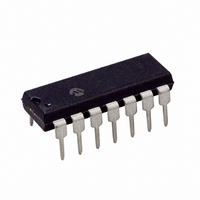PIC16F688-I/P Microchip Technology, PIC16F688-I/P Datasheet - Page 29

PIC16F688-I/P
Manufacturer Part Number
PIC16F688-I/P
Description
IC PIC MCU FLASH 4KX14 14DIP
Manufacturer
Microchip Technology
Series
PIC® 16Fr
Datasheets
1.PIC16F616T-ISL.pdf
(8 pages)
2.PIC16F688T-ISL.pdf
(204 pages)
3.PIC16F688T-ISL.pdf
(6 pages)
4.PIC16F688T-ISL.pdf
(4 pages)
5.PIC16F688T-ISL.pdf
(688 pages)
6.PIC16F688-EP.pdf
(174 pages)
Specifications of PIC16F688-I/P
Program Memory Type
FLASH
Program Memory Size
7KB (4K x 14)
Package / Case
14-DIP (0.300", 7.62mm)
Core Processor
PIC
Core Size
8-Bit
Speed
20MHz
Connectivity
UART/USART
Peripherals
Brown-out Detect/Reset, POR, WDT
Number Of I /o
12
Eeprom Size
256 x 8
Ram Size
256 x 8
Voltage - Supply (vcc/vdd)
2 V ~ 5.5 V
Data Converters
A/D 8x10b
Oscillator Type
Internal
Operating Temperature
-40°C ~ 85°C
Processor Series
PIC16F
Core
PIC
Data Bus Width
8 bit
Data Ram Size
256 B
Interface Type
SCI/USART
Maximum Clock Frequency
20 MHz
Number Of Programmable I/os
12
Number Of Timers
2
Operating Supply Voltage
2 V to 5.5 V
Maximum Operating Temperature
+ 85 C
Mounting Style
Through Hole
3rd Party Development Tools
52715-96, 52716-328, 52717-734
Development Tools By Supplier
PG164130, DV164035, DV244005, DV164005, PG164120, ICE2000, DM163014, DM164120-4
Minimum Operating Temperature
- 40 C
On-chip Adc
8-ch x 10-bit
Data Rom Size
256 B
Height
3.3 mm
Length
19.05 mm
Supply Voltage (max)
5.5 V
Supply Voltage (min)
2 V
Width
6.35 mm
Lead Free Status / RoHS Status
Lead free / RoHS Compliant
For Use With
AC162066 - HEADER INTRFC MPLAB ICD2 20PINAC162061 - HEADER INTRFC MPLAB ICD2 20PINDM163029 - BOARD PICDEM FOR MECHATRONICSAC162056 - HEADER INTERFACE ICD2 16F688ACICE0207 - MPLABICE 14P 300 MIL ADAPTERAC124001 - MODULE SKT PROMATEII 8DIP/SOIC
Lead Free Status / Rohs Status
Lead free / RoHS Compliant
Available stocks
Company
Part Number
Manufacturer
Quantity
Price
Company:
Part Number:
PIC16F688-I/P
Manufacturer:
MICROCHIP
Quantity:
26
Company:
Part Number:
PIC16F688-I/P
Manufacturer:
MOT
Quantity:
61
3.5
The system clock source can be switched between
external and internal clock sources via software using
the System Clock Select (SCS) bit.
3.5.1
The System Clock Select (SCS) bit (OSCCON<0>)
selects the system clock source that is used for the
CPU and peripherals.
• When SCS = 0, the system clock source is
• When SCS = 1, the system clock source is
3.5.2
The Oscillator Start-up Time-out Status (OSTS) bit
(OSCCON<3>) indicates whether the system clock is
running from the external clock source, as defined by
the FOSC bits, or from internal clock source. In
particular, OSTS indicates that the Oscillator Start-up
Timer (OST) has timed out for LP, XT or HS modes.
3.6
Two-Speed Start-up mode provides additional power
savings by minimizing the latency between external
oscillator start-up and code execution. In applications
that make heavy use of the Sleep mode, Two-Speed
Start-up will remove the external oscillator start-up
time from the time spent awake and can reduce the
overall power consumption of the device.
This mode allows the application to wake-up from
Sleep, perform a few instructions using the INTOSC
as the clock source and go back to Sleep without
waiting for the primary oscillator to become stable.
2004 Microchip Technology Inc.
determined by configuration of the FOSC<2:0>
bits in the Configuration Word register (CONFIG).
chosen by the internal oscillator frequency
selected by the IRCF bits. After a Reset, SCS is
always cleared.
Note:
Note:
Clock Switching
Two-Speed Clock Start-up Mode
Executing a SLEEP instruction will abort
the oscillator start-up time and will cause
the OSTS bit (OSCCON<3>) to remain
clear.
SYSTEM CLOCK SELECT (SCS) BIT
Any automatic clock switch, which may
occur
Fail-Safe Clock Monitor, does not update
the SCS bit. The user can monitor the
OSTS (OSCCON<3>) to determine the
current system clock source.
OSCILLATOR START-UP TIME-OUT
STATUS BIT
from
Two-Speed
Start-up
Preliminary
or
When the PIC16F688 is configured for LP, XT or HS
modes, the Oscillator Start-up Timer (OST) is enabled
(see
(OST)”). The OST timer will suspend program
execution
Two-Speed Start-up mode minimizes the delay in code
execution by operating from the internal oscillator as
the OST is counting. When the OST count reaches
1024 and the OSTS bit (OSCCON<3>) is set, program
execution switches to the external oscillator.
3.6.1
Two-Speed Start-up mode is configured by the
following settings:
• IESO = 1 (CONFIG<10>) Internal/External Switch
• SCS = 0.
• FOSC configured for LP, XT or HS mode.
Two-Speed Start-up mode is entered after:
• Power-on Reset (POR) and, if enabled, after
• Wake-up from Sleep.
If the external clock oscillator is configured to be any-
thing other than LP, XT or HS mode, then Two-Speed
Start-up is disabled. This is because the external clock
oscillator does not require any stabilization time after
POR or an exit from Sleep.
3.6.2
1.
2.
3.
4.
5.
6.
7.
3.6.3
Checking the state of the OSTS bit (OSCCON<3>) will
confirm if the PIC16F688 is running from the external
clock source as defined by the FOSC bits in the
Configuration Word (CONFIG) or the internal oscillator.
Over bit.
PWRT has expired, or
Wake-up from Power-on Reset or Sleep.
Instructions begin execution by the internal
oscillator at the frequency set in the IRCF bits
(OSCCON<6:4>).
OST enabled to count 1024 clock cycles.
OST timed out, wait for falling edge of the
internal oscillator.
OSTS is set.
System clock held low until the next falling edge
of new clock (LP, XT or HS mode).
System clock is switched to external clock
source.
Section 3.3.1
TWO-SPEED START-UP MODE
CONFIGURATION
TWO-SPEED START-UP
SEQUENCE
CHECKING EXTERNAL/INTERNAL
CLOCK STATUS
until
1024
“Oscillator
PIC16F688
oscillations
DS41203B-page 27
Start-up
are
counted.
Timer















